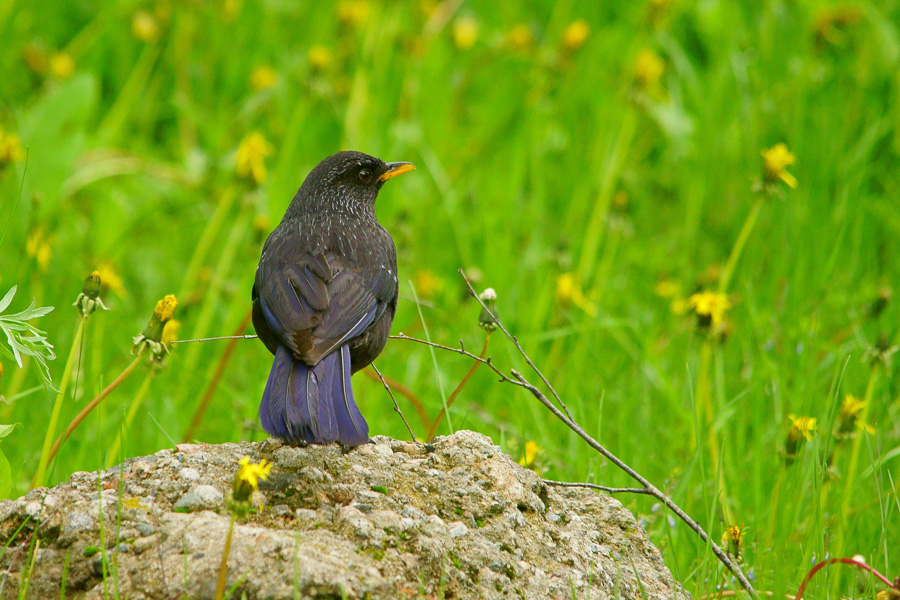A long-term collaborative conservation project between the RSPB, the Government of Kazakhstan and partners has been announced at COP15 as one of 10 “World Restoration Flagship” projects by the United Nations.
- The status has been awarded in recognition of the Altyn Dala Conservation Initiative’s efforts to conserve and restore the ecosystems of the famed Kazakh steppe, wetlands, and deserts for the benefit of Saiga antelope and other globally important wildlife.
- Having recently celebrated the designation of a new 781,000 hectare protected area in western Kazakhstan, Altyn Dala’s work spans an area of 75 million hectares – an area large enough to be visible from space
Today the United Nations have announced their 10 World Restoration Flagship projects under the UN Decade on Ecosystem Restoration. Unveiled at the COP15 Convention on Biodiversity conference, the spotlight has been shone on Altyn Dala as one of the recipients of the award.

Blue Whistling Thrush, Kazajhstan, copyright Szymon Bartosz, from the surfbirds galleries
The initiative, based in Kazakhstan, was co-founded by the RSPB 16 years ago and has seen expert conservation efforts from a wealth of partners, including the Government of Kazakhstan and the Association for the Conservation of Biodiversity of Kazakhstan (ACBK).
Founded in response to the plight of the Saiga antelope, an IUCN Critically Endangered species, the initiative is based across the species’ roaming ranges of the Kazakh steppes and deserts, spanning an area of 75 million hectares. Visible from space, a series of vast connected protected areas is being created to conserve the habitat for the Saiga antelope and other globally important wildlife.
Having recently celebrated the declaration of a new 781,000 hectare protected area in western Kazakhstan, conservation efforts so far have enabled Saiga antelope numbers to bounce back after previously being threatened with extinction. Thanks to the major long-term efforts of the Government of Kazakhstan, alongside the RSPB and partners, the numbers have dramatically recovered from less than 40,000 individuals in 2005 to 1.32 million now roaming the steppes of Kazakhstan.
For UNEP executive director Inger Andersen, the revival of the Saiga is “one of the world’s great conservation success stories. It is a sterling example of what humanity can do when we act decisively to restore sensitive ecosystems.”
These amazing results now mean that Kazakhstan supports more than 95% of the global population of Saiga antelope, with the steppes also providing a home for other important wildlife including iconic Steppe Eagles, many millions of migratory birds and a remarkable diversity of resident small mammals. What’s more, as the initiative progresses, it continues to provide jobs for local people, and enhance understanding of the unique habitats, flora and fauna found in Kazakhstan through research and education.
Speaking of the award, Katie-Jo Luxton, RSPB executive director of global conservation said: “We are thrilled that the United Nations has chosen Altyn Dala as one of their World Restoration Flagships, and we look forward to continuing to work alongside all our partners to further conserve and restore the natural grasslands, wetlands, and deserts of Kazakhstan.
Using conservation science in this way has only been made possible thanks to long-term partners like ACBK who, in close collaboration with the Kazakh Government’s Committee for Forestry & Wildlife, are at the forefront of Saiga antelope study and conservation.
With nature in crisis across the globe, this award recognises just what can be achieved when organisations come together to save nature. At COP15, being held in Montreal as we speak, we need a commitment to forming more partnerships like Altyn Dala; spanning a range of nations, organisations and authorities to deliver at scale and with lasting positive impacts for nature and climate.”